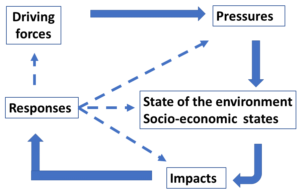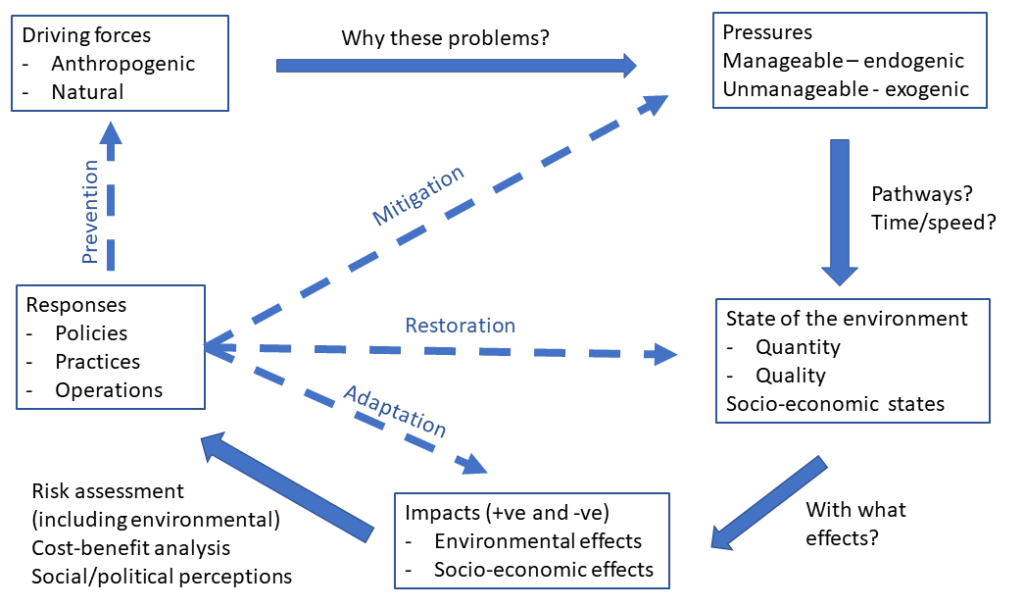Using a DPSIR framework to support good natural resource management and policy

This post provides an introduction to an extended DPSIR (Driving Forces-Pressures-State-Impacts-Responses) framework, and looks to show how this can be used to more closely link the social and natural sciences to better help policy makers address complex problem situations. It also offers some pointers to how the framework can be used to support the development of just and equitable transitions.
As pressures on the environment and our linked socio-ecological systems increase we need systems thinking and systems-based frameworks that can be used to conceptualise complex sustainability challenges. Such frameworks can help organise research that increases understanding about interacting and co-evolving ecological and societal processes, evaluate trends over time, and supports the systemic co-design of constructive management interventions at multiple levels.
A systems approach to complex problem situations
Without such frameworks, research, management and policy initiatives are frequently limited to a particular issue or field of concern, and can often address a single aspect of a problem with insufficient understanding or consideration of short- and long-term consequences to the larger system. Additionally, the many stakeholders involved in today’s complex problems all too often may find themselves implementing multiple, uncoordinated management actions. While each of these actions may be successfully implemented for a particular purpose, the combined effects may not lead to improved environmental conditions. Often too the social and biophysical sciences can be seen to operate independently of each other, and a focus on technical and biophysical means that equity and justice considerations are marginalized. Standing in contrast to such linear and reductionist thinking, systems thinking sets out to view systems in a holistic manner. A systems approach considers more than one issue and broadens the decision context. The DPSIR framework is one such systems approach designed to help structure and communicate policy and management relevant research about the environment.
From a natural resource management and policy point of view the DPSIR framework highlights the need for clear and specific information on a number of factors in an interlinked socio-economic and ecological system. It helps us define what we know about five key components. These are driving forces and their resulting environmental pressures on environmental and socio-economic states, the impacts resulting from these, and the subsequent societal responses (Figure 2). Different groups use these terms in slightly different ways, dependent on their disciplinary backgrounds – and given the diverse range of uses that the framework is put to it probably does not make sense to attempt to create rigid definitions. What is important is that those stakeholders involved in any particular situation use the development of the model to clarify their understanding of the terms, and that it is equally important to develop an integrative and shared understanding and communication of the causal links and mechanisms involved.

A ‘driving force’ can be thought of as primary or secondary or physical and socio-economic to distinguish between natural and human activities. In social terms drivers can be thought of as such things as needs for food, shelter, water, low unemployment, and economic wealth. Primary anthropocentric driving forces are likely to include population growth and accompanying developments in the needs and activities of individuals, communities and sectors. These driving forces provoke changes in the overall levels of production and consumption, and impact on the environment. Driving forces exert ‘pressures’ on the environment. Pressure indicators describe developments – for example in the movement of pests/pathogens, the use of related resources, and the use of land by human activities. The pressures exerted by society are transported and transformed in a variety of natural processes to manifest themselves in changes in environmental conditions.
In turn, these changes then have impacts on the functions of the environment, such as human health, resources availability, ecosystem services, and biodiversity. Impacts are consequences of environmental state change in terms of substantial natural or socio-economic effects which could be either positive or negative. Impact indicators are used to describe changes in these conditions. Response activities/indicators refer to attempts by groups (and individuals) in society, as well as government to prevent, compensate, ameliorate or adapt to changes in the state of the environment. Some societal responses may be regarded as negative driving forces, since they aim at redirecting prevailing trends in consumption and production patterns. Other responses aim at raising the efficiency of products and processes, through stimulating the development and penetration of more effective technologies or practices. As illustrated in the figure responses may seek to control driving forces or pressures (prevention or mitigation respectively), to maintain or restore desired end states (be they socio-economic or ecological), or to help accommodate impacts (adaptation). In some cases the deliberate response may be to choose a strategy to “do nothing”, or perhaps just “wait and see”.
Although it is tempting to look at the DPSIR framework as a descriptive analysis with a specific focus on individual elements in the economic, social and environmental system, it is the relationships between the elements that introduce the dynamics into the framework and bring about changes. A focus on the links between the DPSIR elements reveals a number of processes and indicators describing these. For example, eco-efficiency indicators help determine the relationship between the driving forces and pressures. Increasing eco-efficiency may indicate that economic activities can expand without an equivalent increase in pressure (or at least the same pressure) on the environment. This kind of information contributes to answering the question: are we making technological progress? Similarly, the relationship between a pressure indicator and a corresponding state indicator speaks to pathways.
The combination of these indicators tells a story of time delay in natural processes and the corresponding ‘lags’ before environmental and socio-ecological effects fully manifest. And the relationship between environmental impacts and societal responses (such as policies and regulation) are often governed by societal perceptions (for example, that the impacts are serious). In turn assessing the magnitude of this relationship will often require gathering data on the economic costs of the impact. Policy-effectiveness indicators generally summarise the relationships between the response and targets for expected change in driving forces or pressures and sometimes in responses, state or even impacts.
The strength of these ‘in-between’ indicators is that they express, more than other indicators, the dynamics of the interactions in the DPSIR system. Sometimes the information can be used in predictions of future changes in pressures, states, impacts, and responses. The existence of these interrelationships also shows that the DPSIR framework, although often presented as a linear chain or a circle, in fact resembles a very complex web of many interacting factors some of which may represent highly non-linear dynamics. In many cases the change in the state of the environment or impacts has several causes, some of which may be immediate and of local origin, others may be exerting their influence on a continental or even global scale. Reductions in pressures often result from a mixture of policy responses and changes in various driving forces, including practices.
Integrating equity and social justice considerations in a DPSIR framework
Common to many reviews pointing to good governance are elements of equity and social justice, stakeholder inclusion, strategic thinking, accountability and fairness. Many of these key elements are also those that support adaptive management, social learning, and that lead to the development of resilient communities. However, despite this growing scientific and policy endorsement equity and other social and justice concerns are often marginalized. As Joyeeta Gupta and colleagues (2020) remind us, this is true as well of the DPSIR framework, which has traditionally marginalized equity issues except to a limited extent in the impacts and response component. In their paper these authors offer some underlying questions which can be asked at each stage of the framework to require some thought to be given to include equity and inclusive development perspectives. These questions are shown in the table below:
| Drivers | How do drivers result from, mitigate or exacerbate inequalities? |
| Pressures | Who uses and benefits from resources and sinks? |
| States | How is exposure to risks and benefits distributed? |
| Impacts | How are impacts distributed? Who is able to adapt; who pays for residual damages? |
| Responses | How do responses redistribute rights, risks and responsibilities? |
Supporting communication and integration with a DPSIR model
As pointed out above, a DPSIR framework offers users the potential to bridge natural and socio-economic systems. It also provides an applicability to help stakeholders link science with policy and management, as well as think about equity, just transitions and inclusive development issues. In these ways it can contribute towards supporting sustainable and just management of our underlying natural resources, and ensuring that we develop practical and transformational pathways forward.
The framework has a number of underlying strengths. These include its communicative power as a boundary object, the illustration of cause-effect linkages underlying environmental problems, and the provision for multi-stakeholder participation. It supports an interdisciplinary approach, and can be particularly useful in bridging across the social and natural sciences divide. Natural scientists may have a focus on contributing to the pressure/state side, while many social scientists may find a more natural focus on the impact/response/drivers side. Equally the framework is supportive of linking science more closely with policy and management.
Using a DPSIR framework serves to provide a common model and language for natural resource managers, policy makers, scientists of different disciplines and stakeholders. However, there are a number of papers on the challenges of interdisciplinary and transdisciplinary research that remind us of the challenges in connecting and integrating social and natural science data and knowledge, and that there is often an ongoing disconnect in how different disciplines engage with this and other integrative frameworks. Accordingly, as we move more towards a recognition that the social learning-based process of participation and dialogue is important, we also need to pay attention to ensure that processes are managed by well developed skills in systems thinking, relationship-building and facilitation. To take up these challenges as Allen et al. (2011) point out, interdisciplinary and other integrative approaches that seek to use DPSIR and other such frameworks need to include personnel with complementary skills in the management of participation and conflict, and the integration of biophysical and social aspects of collaborative learning.
More information on related approaches, tools and methodologies can be found through the linked LfS pages on systems thinking, design thinking and systems thinking tools. Other pages point to resources on topics such as guides to help initiate and manage multi-stakeholder processes, managing participation – including marginalized voices, facilitation tools and reflective practice.
An independent systems scientist, action research practitioner and evaluator, with 30 years of experience in sustainable development and natural resource management. He is particularly interested in the development of planning, monitoring and evaluation tools that are outcome focused, and contribute towards efforts that foster social learning, sustainable development and adaptive management.

Leave a Reply